May 28, 2017
Martha O'Kennon
What a week! There were all sorts of different kinds of "bugs" and I didn't even stay outside too long at a time. I did do several short walks, and each one seemed to feature its own delightful creatures. I've looked at some of them before but this year they gave me more of a chance to really stare at them. I promise you at least one very shockingly interesting new addition to the garden family. Since the garden party has opened up, almost all the pictures have a combination of flowers (including a lot of raspberry blossoms) and "pods" (arthropods). But the week specialized in dame's rocket, which looks like phlox but comes in the spring. Here are also the overnight berries for the false solomon's seal. If they manage to ripen, they will be a mass of bright red in the late summer. Remember how glorious the tulips were this year? Well, so was the red rhododendron - it had about 20 large flowers this year, after only 13 last year.


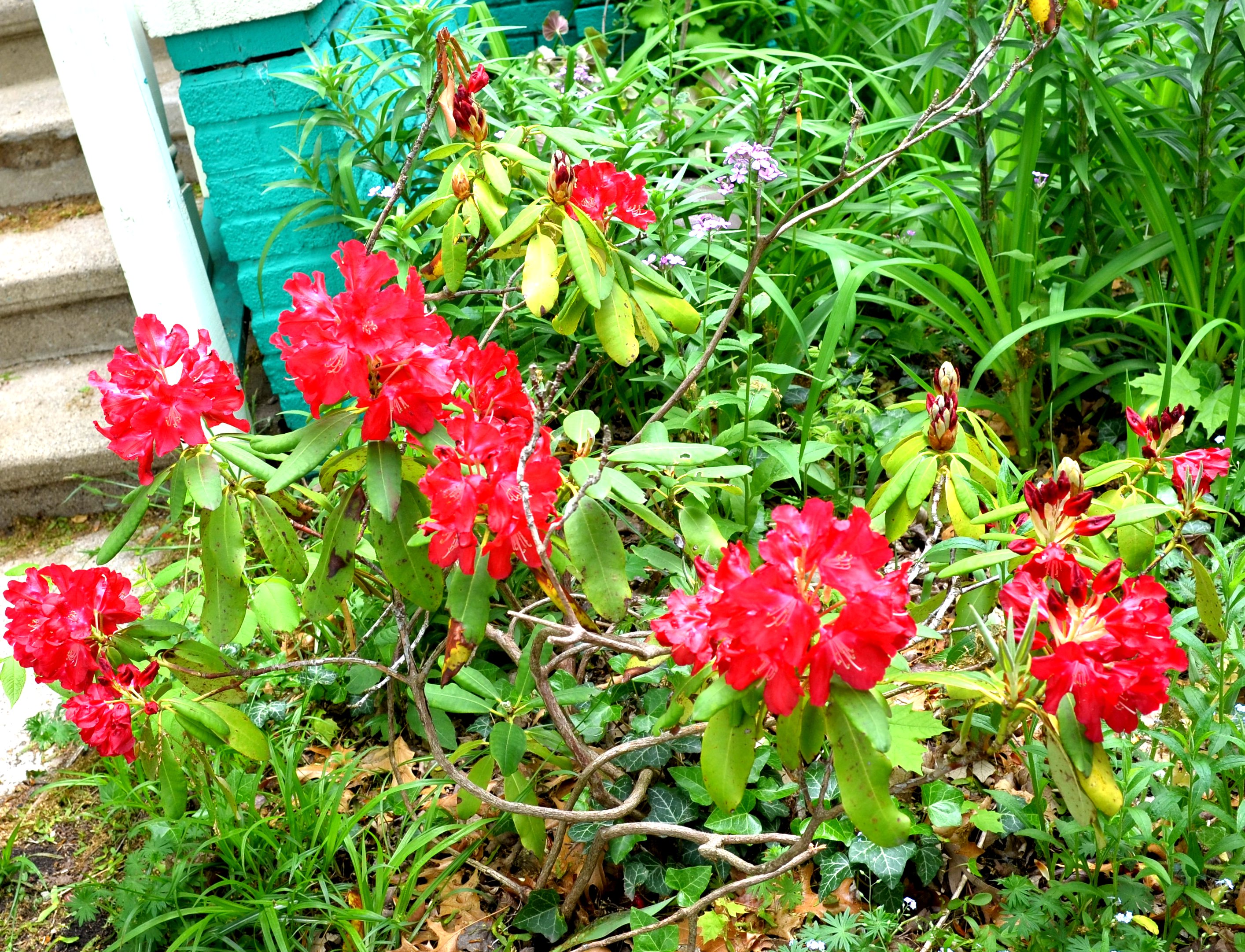
The usual several "kinds" of Carpenter Ants, including this ginormous one (I just can't keep my eyes off it), were there. But other sizes and shapes have started showing up too. This small ant was on a dock plant. The barklouses (barklice) are also reliable visitors. First was this very "plain" one and then we had quite a few of what I consider to be one of the more attractive narrow barklouses, Graphopsocus cruciatus. For perspective, remember that these barklouses are about 2 mm long, so we're really lucky to see them at all!


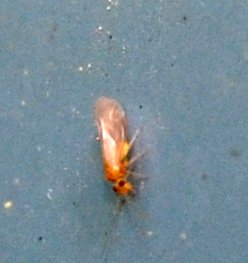
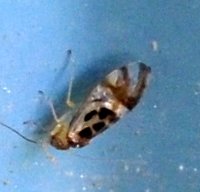
Remember that there is information in the name of the file for each image. You can see it by mousing over the image - look at the lower left of the screen.
Or you can click on the image to get to the (usually) larger image. Then the info is displayed in the address line above.
The bees are buzzing. I'm pretty sure this first one is our very old friend, the Honey Bee. All of them love the raspberry flowers! The subsequent images are front and back of a new one.
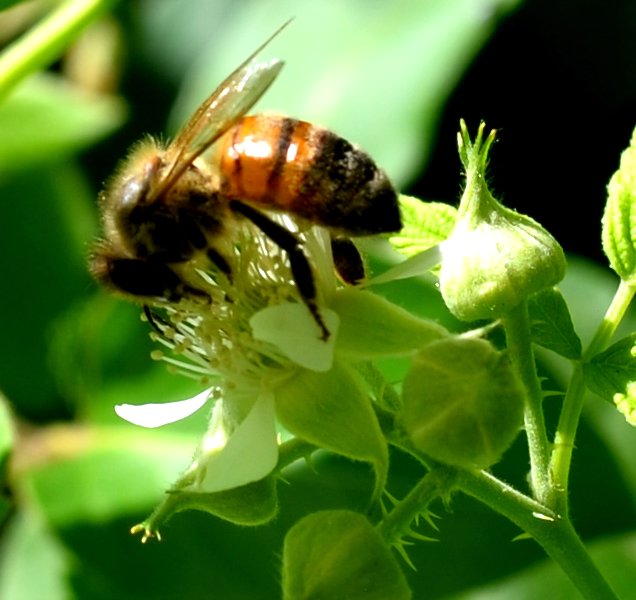
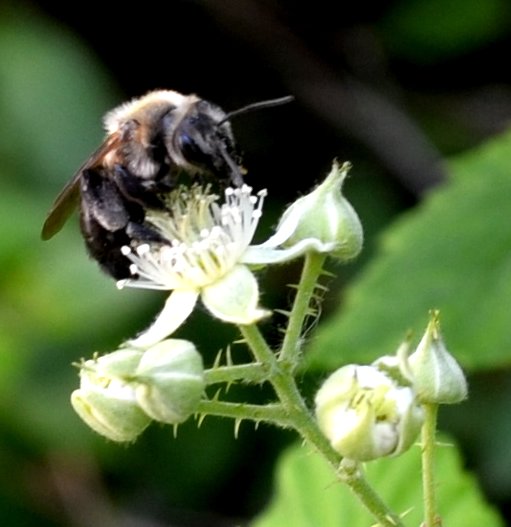
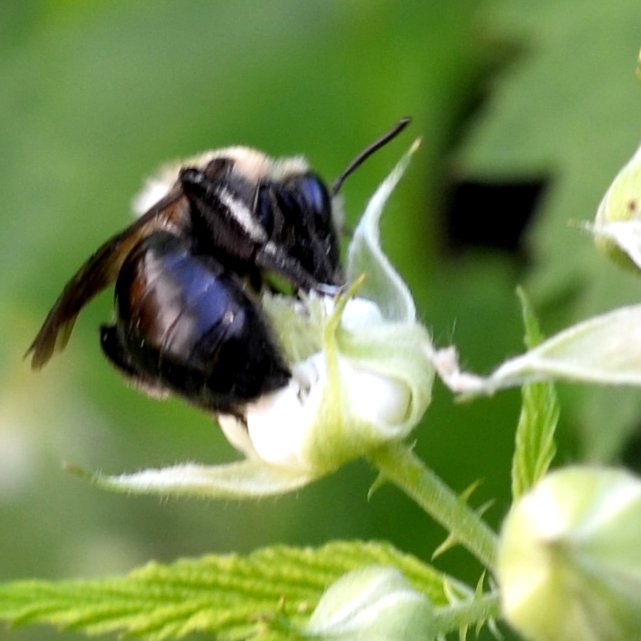
This one is still unidentified, but it sat so primly for the camera, I will probably be able to ID it soon. This orangish one was here last year as well. The second image is as it was last year (2016). It was a kind of mason bee, by what identifications I could find. One that we had seen by this time of spring in 2015 and 2016 was the nomad bee, a lovely purplish and not too skittish bee.
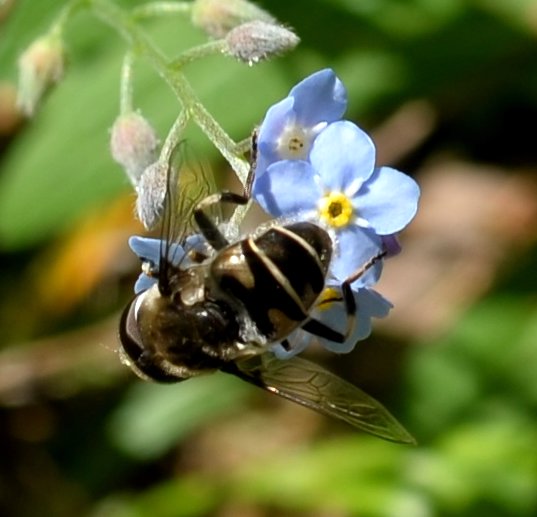


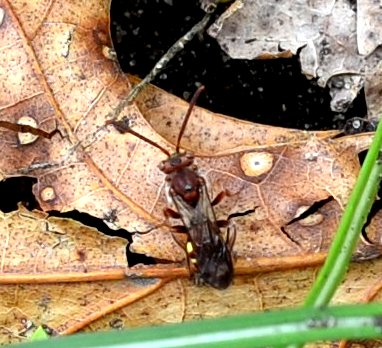
Beetles are also coming along. This was the first time I saw one of these Leaf Beetles, on goutweed flowers. And I haven't figured out this very long beetle. Nor this one. Could they be the same species? The colors almost match...
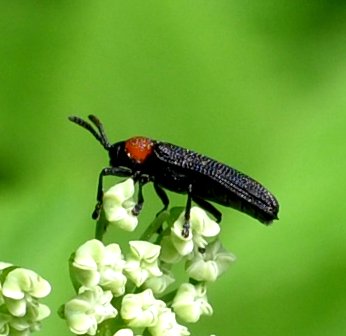

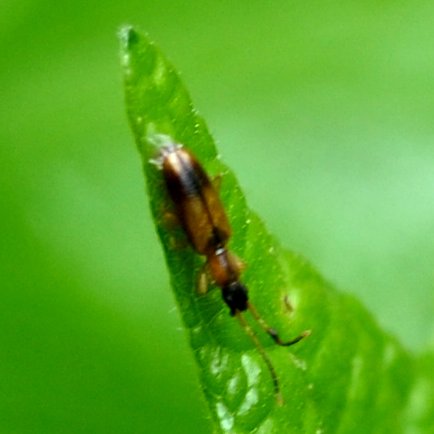
Weevils (beetles with extra snout technology) are also coming along. a) Who invented this violent yellowish green? b) Who said the redbud bruchids should be in every day's bag of pictures? c) Whoever invented the yellowish green in (a) must have also created this gorgeous mixture of greens and browns.
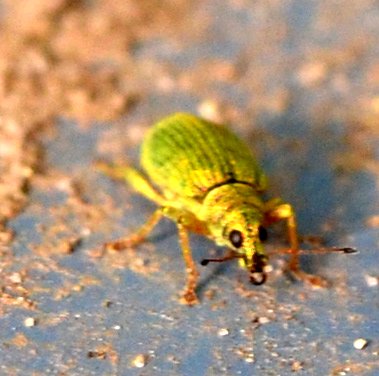
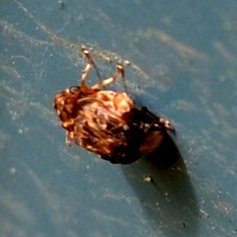

This assassin bug with the red eyes has to be the adult of Zelus luridus, our most frequently spotted nymph in this world. Next bug: My milkweed must be growing somewhere - this Small Milkweed Bug kept appearing and falling to the ground when aimed at. Finally, a mystery leafhopper, so small and pale and almost invisible.

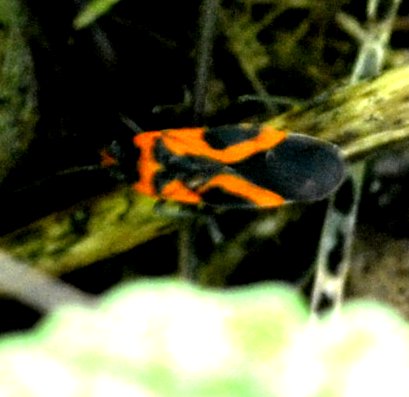

What can this little yellowish-green creature be? It reminded me somewhat of one of the little katydid nymphs. It turns out to be just that, a Scudder Katydid nymph (one of two species) but at a much (week or two) smaller size. Here is a picture of the youngest katydid nymph I ever photographed. It was taken in June 2009, and actually I can't see a lot of difference between it and the first image (new youngest orthoptera nymph taken this week). Number 3 here is a stink bug, and you don't need to feel guilty at not squashing it. (In other words, this is NOT a bad bug so far!). It seems to belong to the Euschistus genus, but note how pretty its antennae are. The second is one of those white-margined burrowing bugs. Please don't get upset that I put two images of Orthopteran nymphs in here with a couple of bugs. Orthoptera are quite a bit further down the insect family tree than Hemiptera (true bugs).
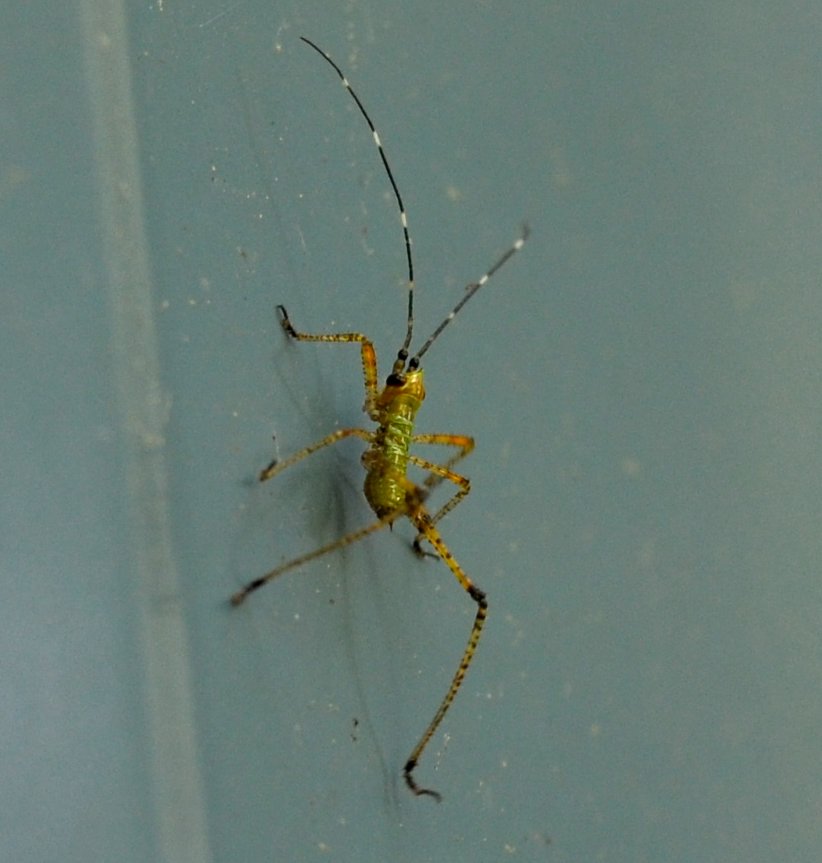
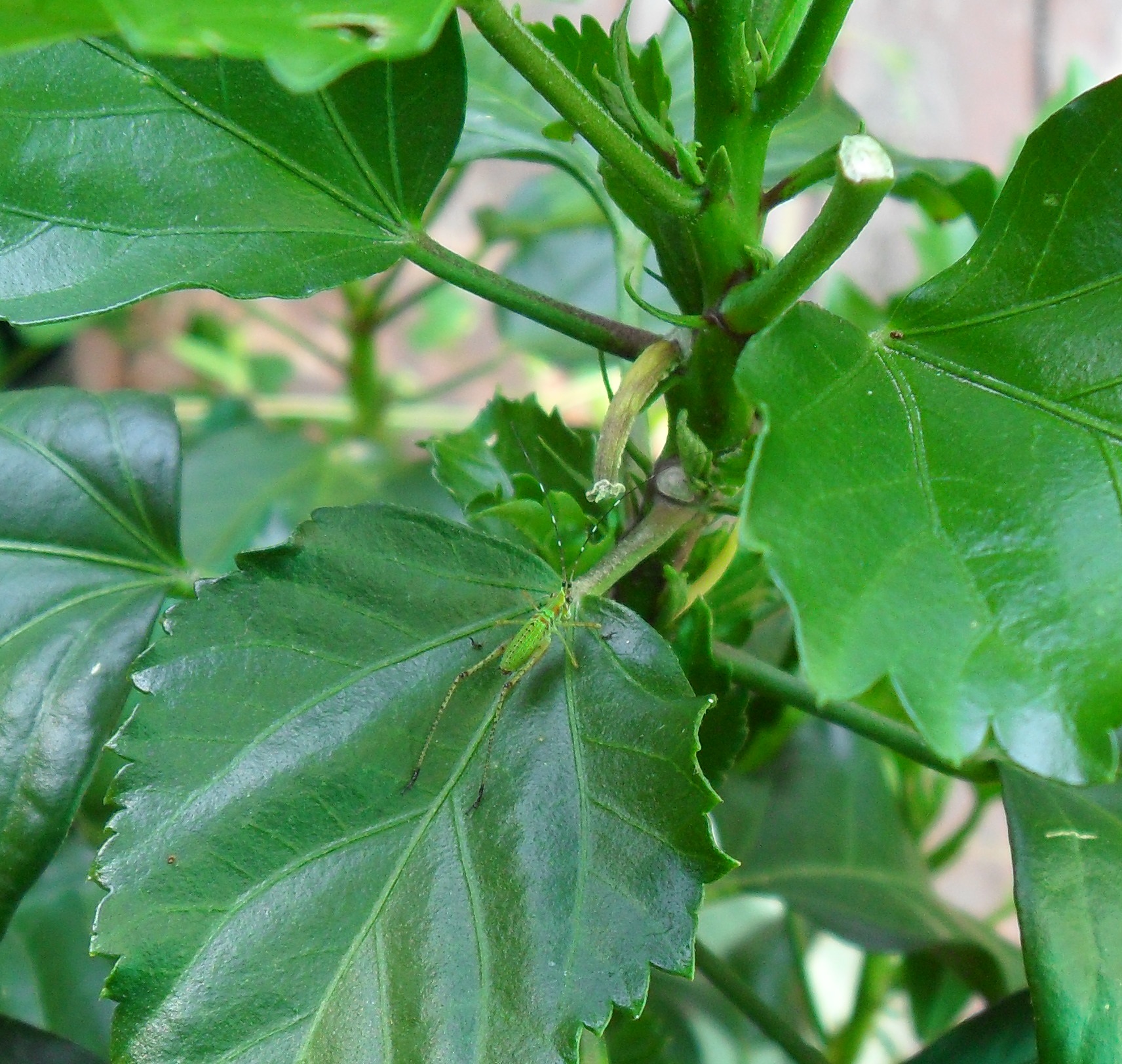
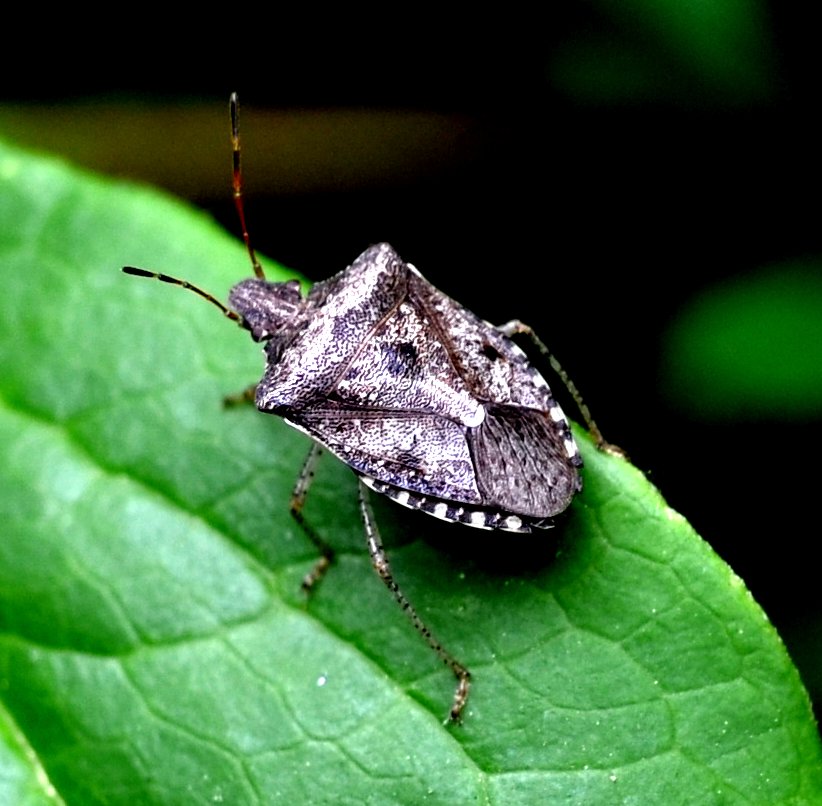

Here's that columbine that's been growing up over near the outside water turnon. The yard used to have a lot of these flowers. The next columbine either planted itself or begged me to plant it at the very edge of the front flower bed. It may have been a beautiful blue (more later on that). Now for something going through a ton of changes and stages, look at this bunch of oak leaves just starting to quietly turn on their color display.

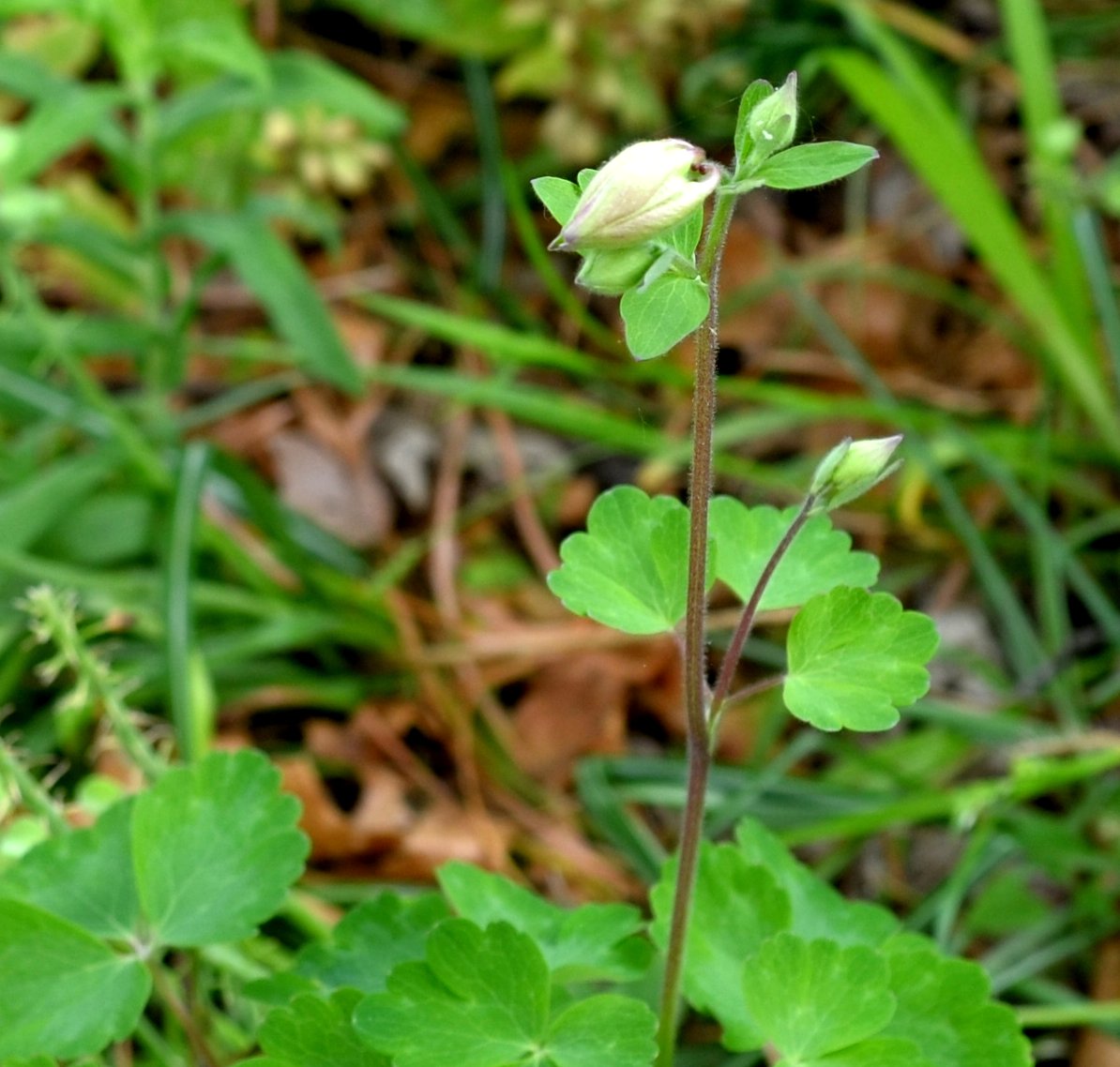
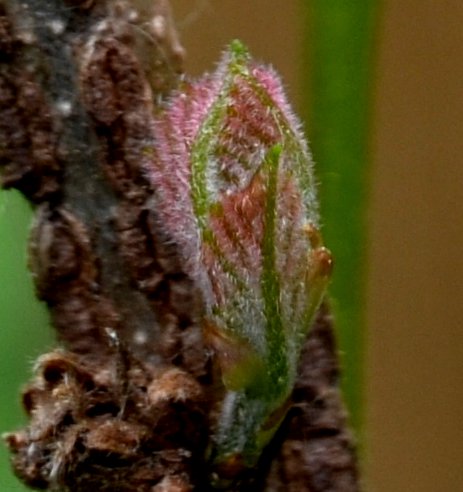
This beautiful iridescent fly has the somewhat off-putting name of Blow Fly (Calliphoridae). The second image shows you just how hairy and spiky it is. But what colors! The beautiful blue-winged fellow is almost invisible without some magnification but may be a carnivorous fly.
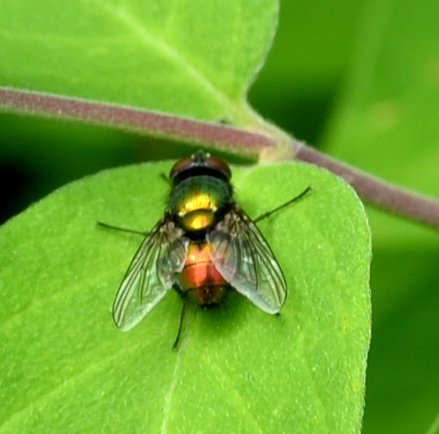

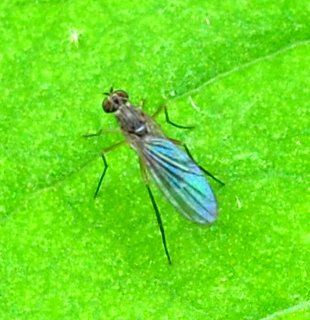
Here's the common snipe again, though they haven't been so common as their name implies, not yet anyway. The first of the following crane flies is the usual size tiger crane fly; the second, who just happened to set itself down in a splendid spot, its orange markings against its purple wings (an artifact of the shade, I'm sure), hidden behind a raspberry bloom cluster. Be sure to click on this picture so that you can see how the zoom works on it.
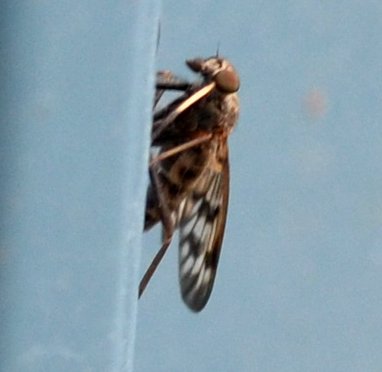
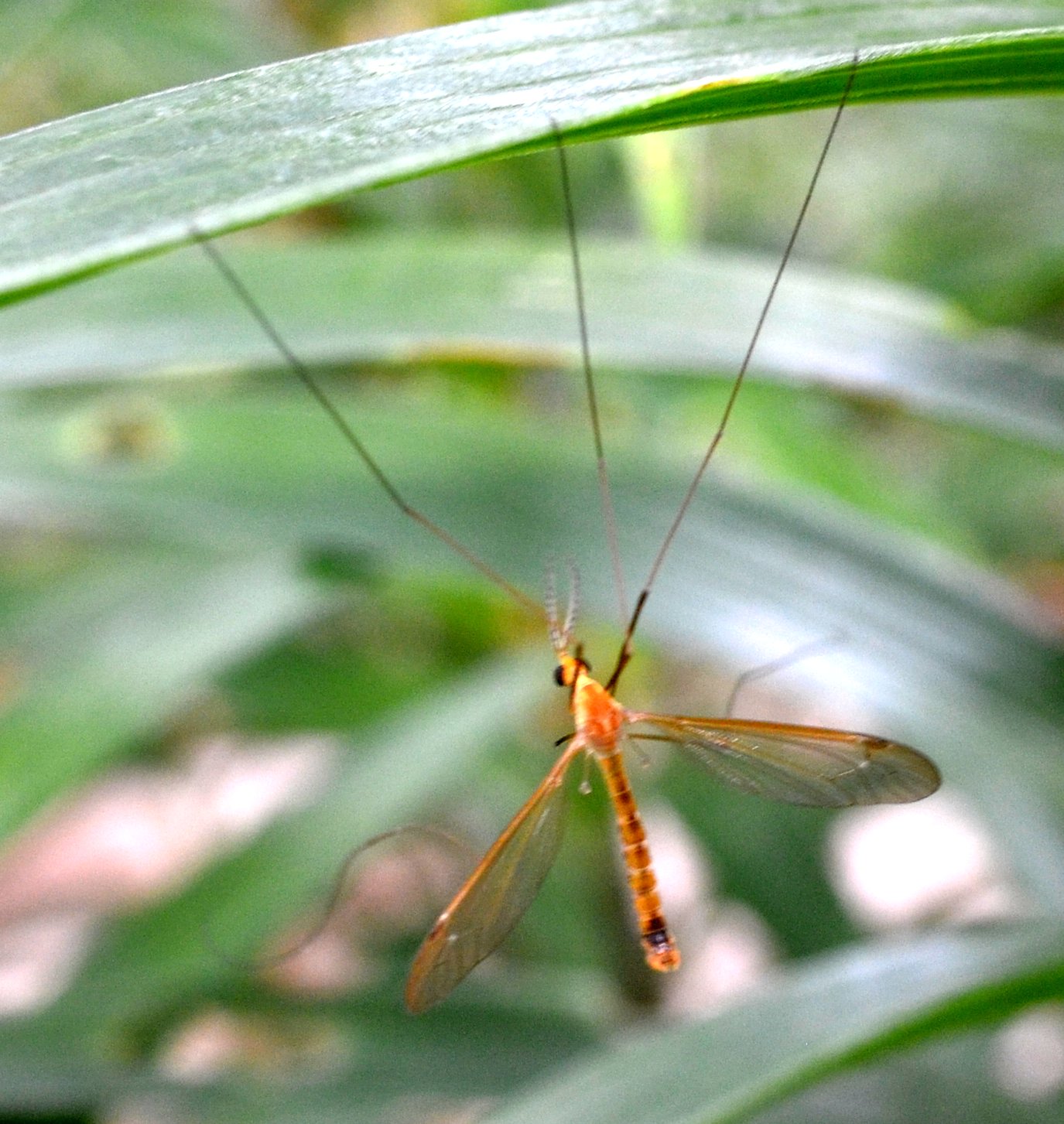
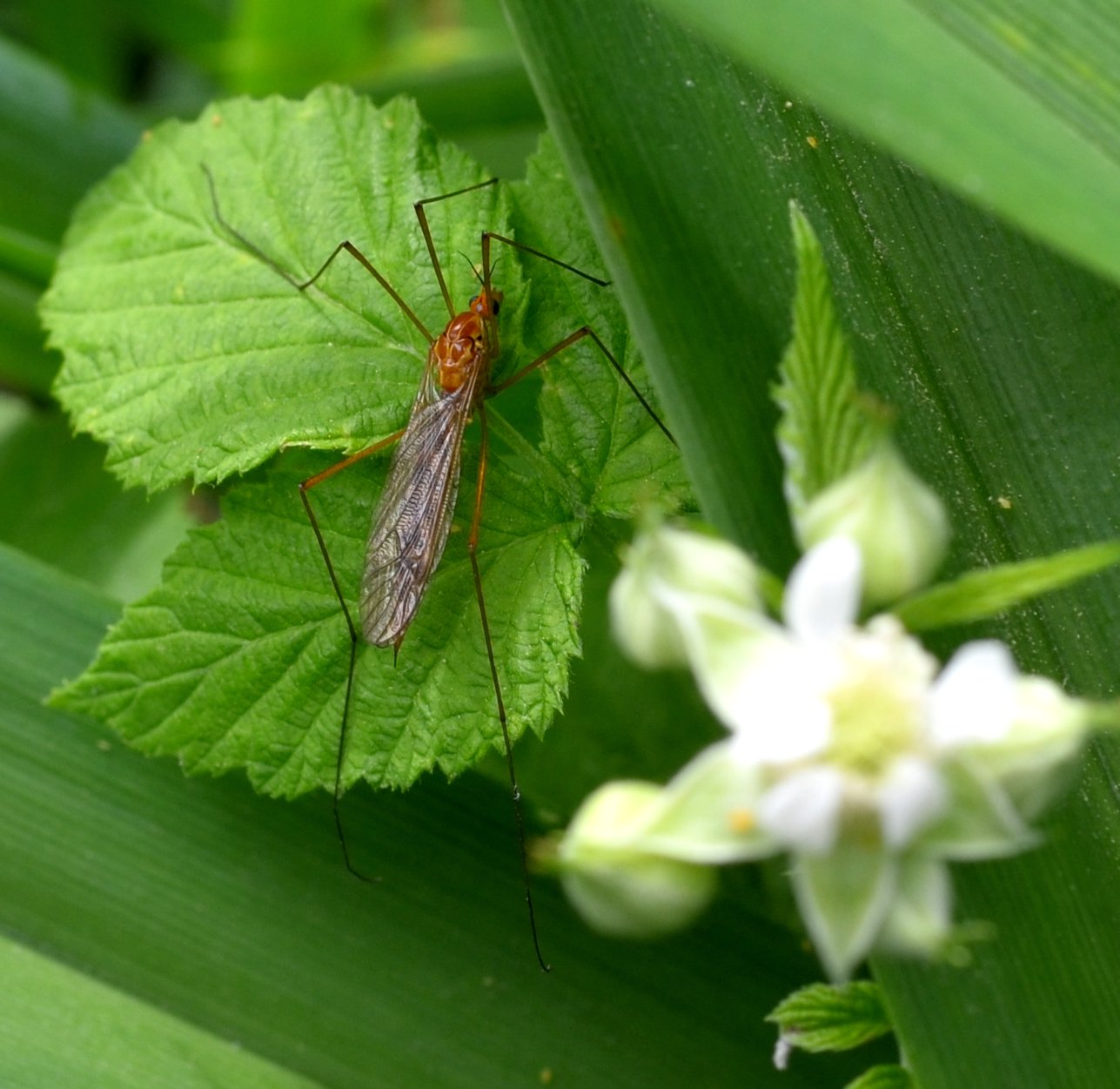
Here are the march flies again, first the smallish male (two specimens) and then the female. Note the female has red femurs so is Bibio femorata (despite her pale blond wing color). The two males may not be B. femorata.
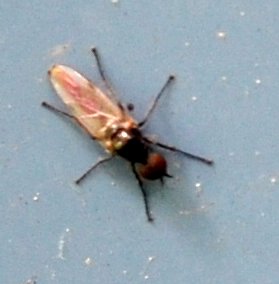
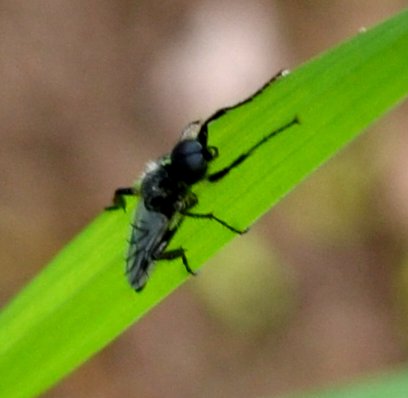
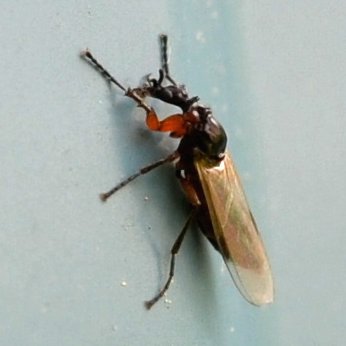
Speaking of the importance of names, does it bother you when this rather pretty fly becomes "dung fly"? The next images are of something unidentified (by me).
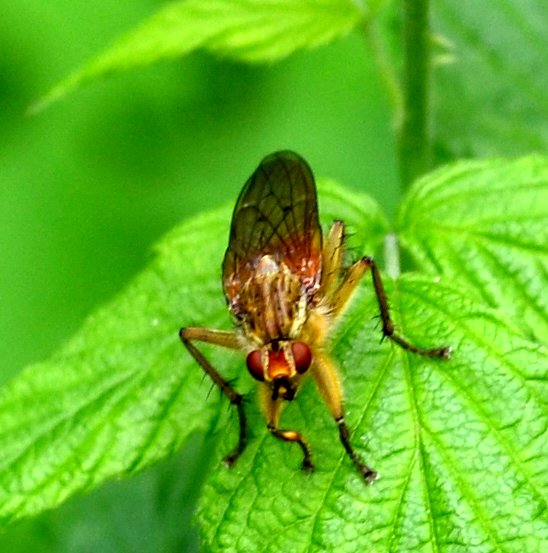
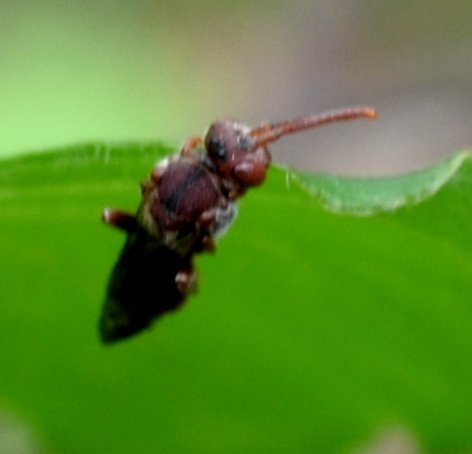
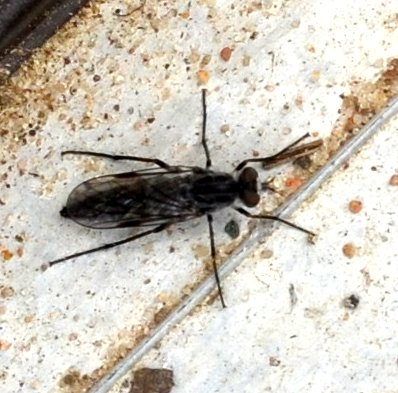
Here are some flies that show off (a) their hairy spiky legs; (b) Big red eyes and an appetite for dead otherbugs; (c) an unidentified female mosquito, and you know what they like for supper.
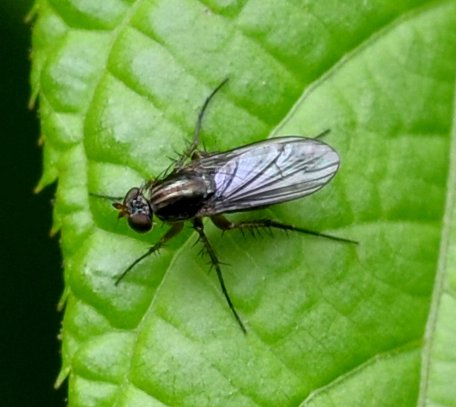
 5 20 17 2.jpg)
 5 21 17 1.jpg)
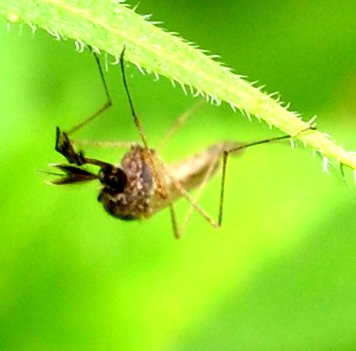
These ones probably attract you because of their beautiful soft color combinations. I don't know what the pretty little red-eyed blue-winged fly is. Next is a marsh fly. The vinegar fly (third) is carrying around a bubble of liquid (vinegar?). There is a discussion on Bugguide here about the phenomenon called "bubbling".

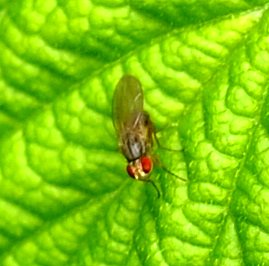
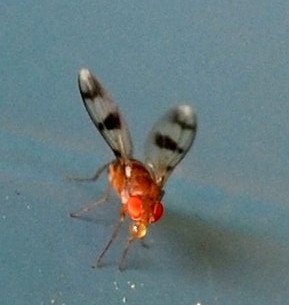
Y'know, the hover flies have started coming back. These flies can really hover right in the air like a very quiet helicopter. There is one that is very recognizable, namely Toxomerus geminatus. It is just tiny. Here is one on a raspberry flower cluster, and another on a forget-me-not. Then there is the Heliophilus fasciatus, a rather large hover fly, but still capable of hovering. This one we saw a few weeks ago on the pond. It lays its eggs on floating leaves like Water Lily pads. This one, however, was in a raspberry patch.
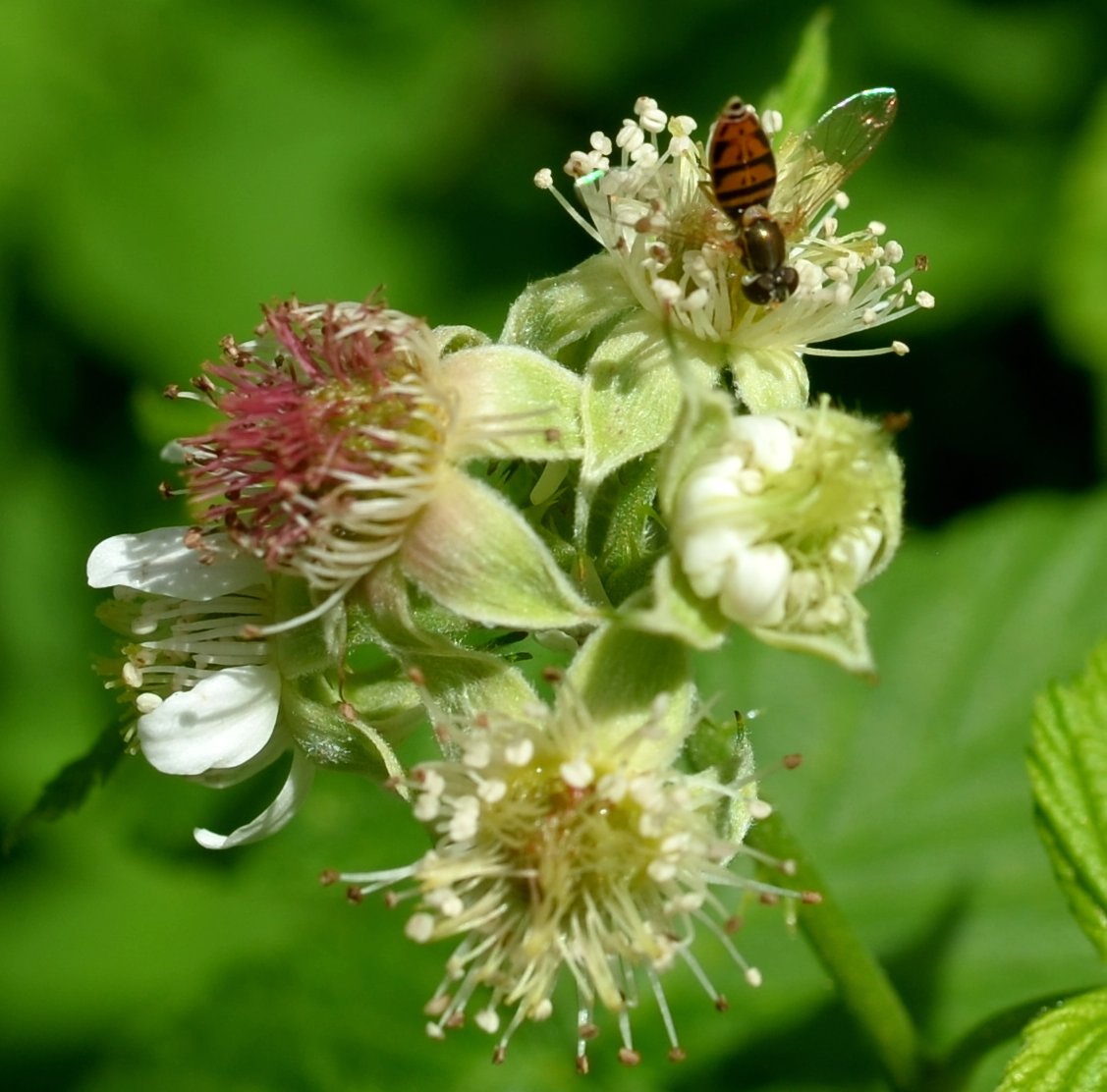
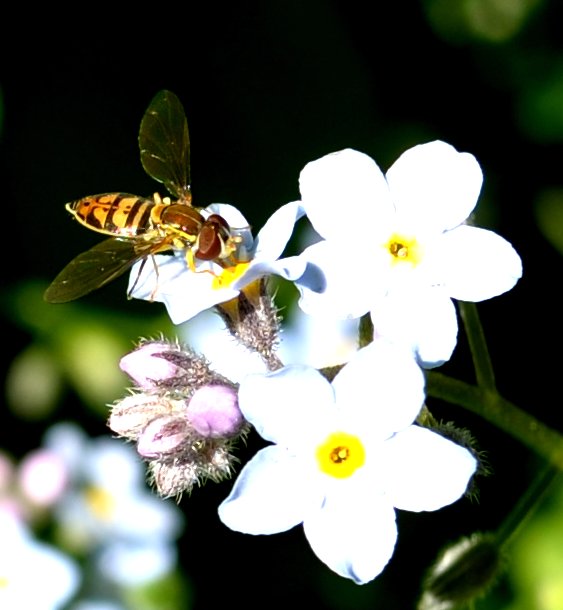

Every year I try to add to my photo collection of hover flies. This year, just yesterday, May 26, I was trying to capture the image of a small strange wasp. It was hovering and drinking from the forget-me-not by the pond. Only when I got a good focus on the wasp and it relaxed for a nice shot on the forget-me-not, only then, and only when I set about a couple of hours later to crop and categorize the wasp, did I see that those are not wasp eyes, they are fly eyes. This "wasp" is a wasp-mimicking fly. What a little trickster! How its little legs are bowed and its little abdomen is bent forward in a most un-fly-like posture!

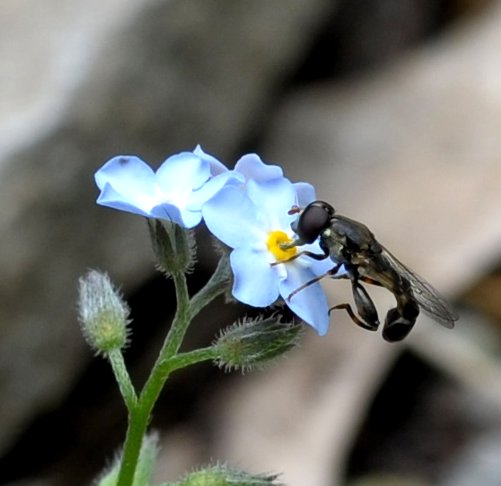
We're about to leave the flies to go visit the harvestmen. And then we'll be seeing the special creature I've been hinting about for days now. The harvestmen have been growing for a while, but they start out like a miniaturized Daddy-long-legs. And gradually their legs get longer and longer.
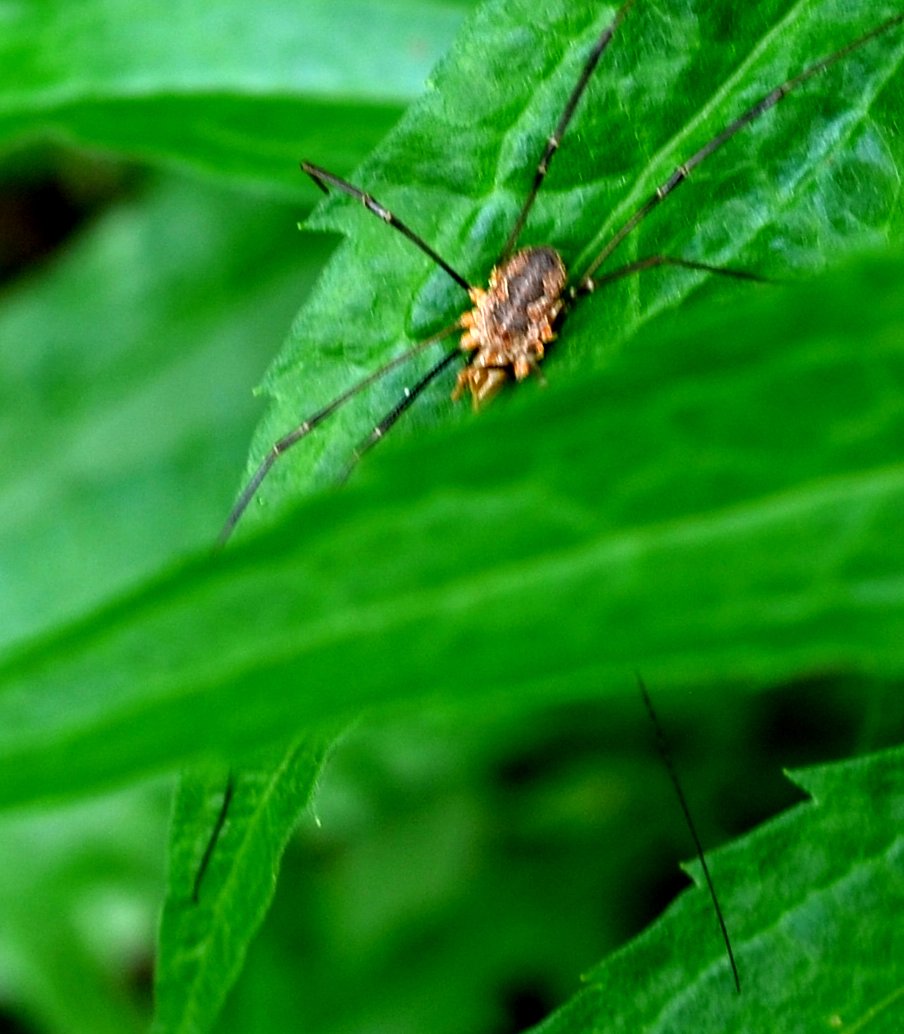
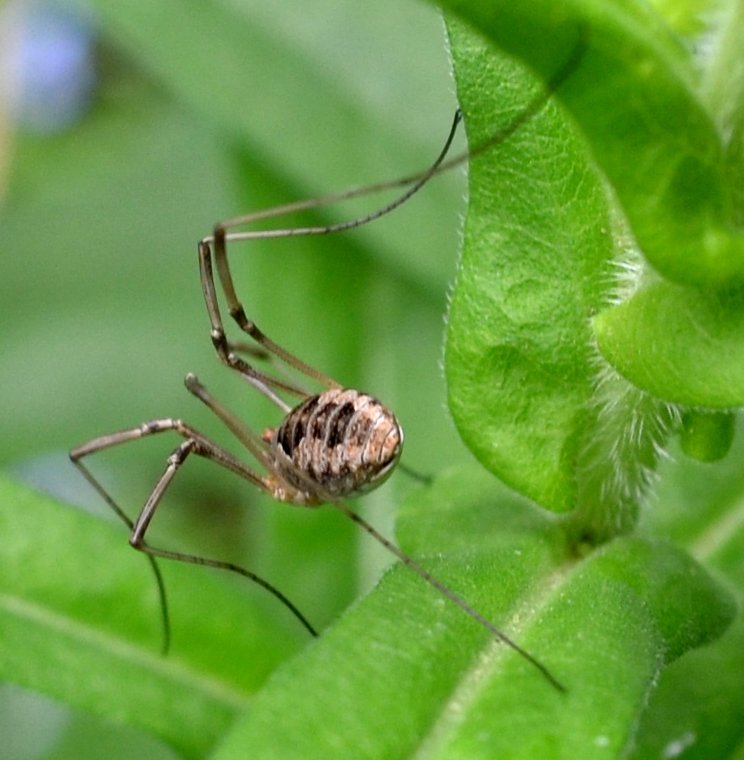
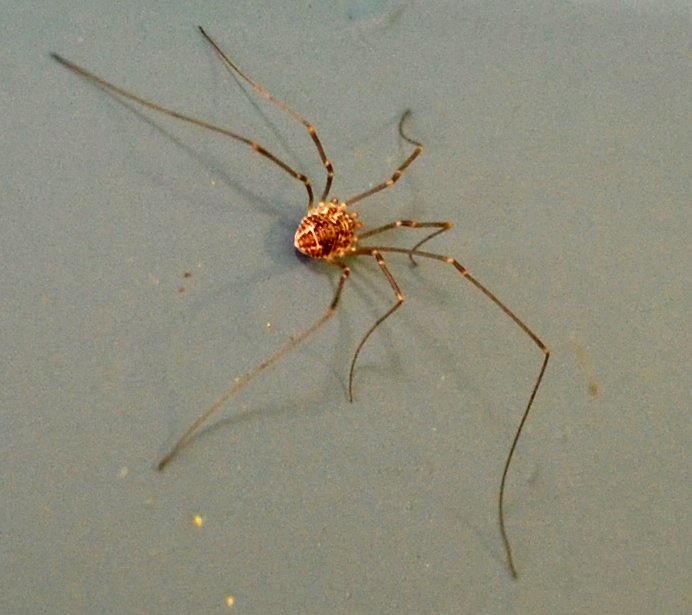
We've been seeing quite a few Ichneumon wasps. These are the mainly meat-eating little members of the Hymenoptera. They tend to be small and fast-moving. But not always. Here are a few from the past week, which has been very ichneumon-rich. This one (two images) is a male. The female would have had a long ovipositor.

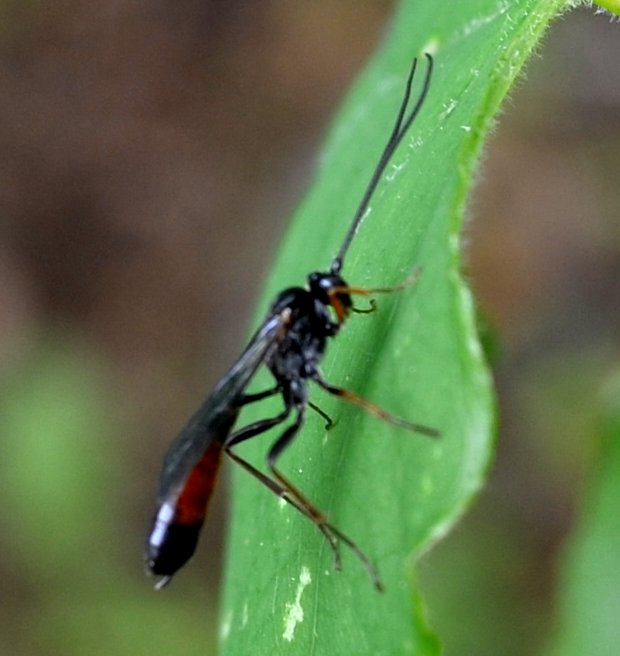
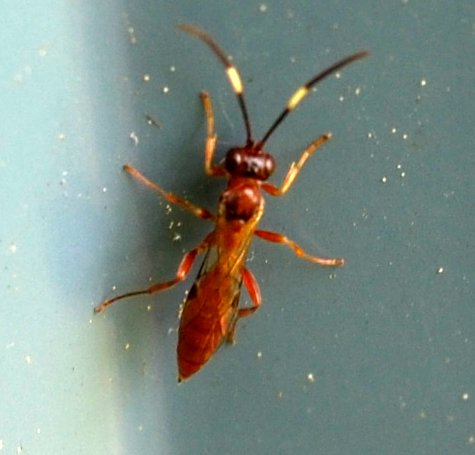
Here are a couple more ichneumon wasps. One person explained it to me that they are often found near rotting wood. Well, they do seem to come in and out of a certain rotting stump (Its tree fell in 2007.) in the sideyard.
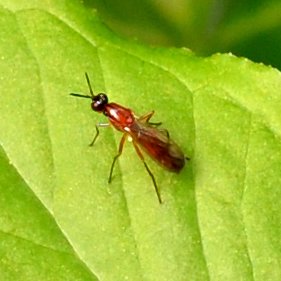
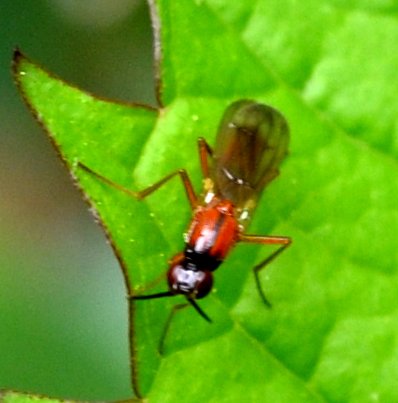
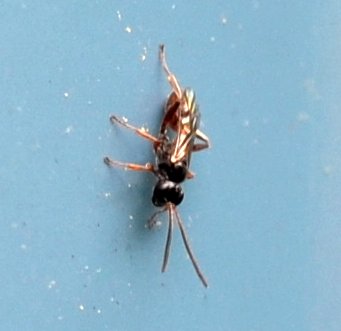
All right, now you've seen some of the ichneumons I saw this week. But on May 22, I was drawn outdoors by a largish insect on the blue siding of my workshop. When I got to it, it was still cool, only about 10-11 am. So it wasn't moving much and let me get quite a lot of shots of it. It looked like a dragonfly but the wings weren't right. I thought it looked more like a cross between a dragonfly and a mayfly. It took me a couple of days to fire off a request to Bugguide.net, and you could have knocked me over with a feather when I got the answer, I was that surprised. It turned out to be no relative of dragonflies, but a Giant Ichneumon Wasp.
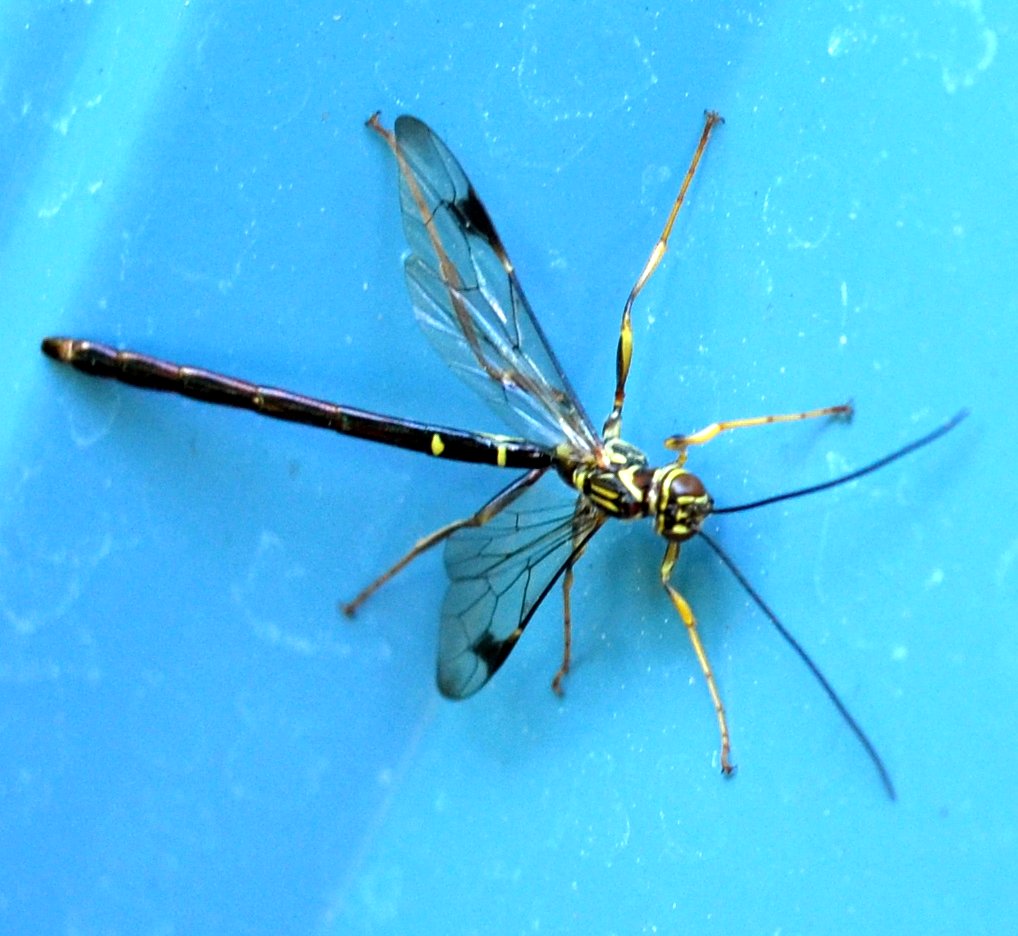
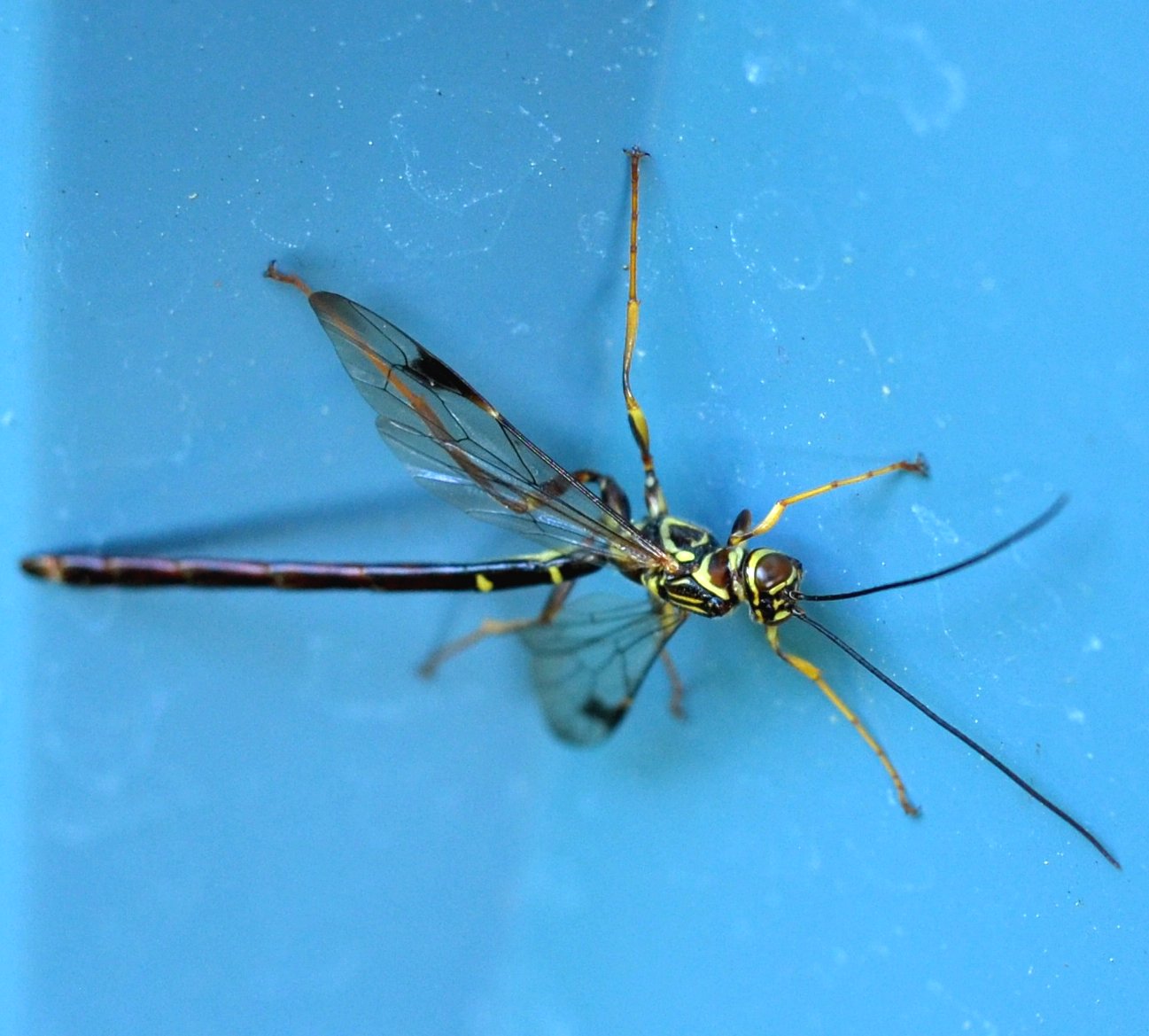
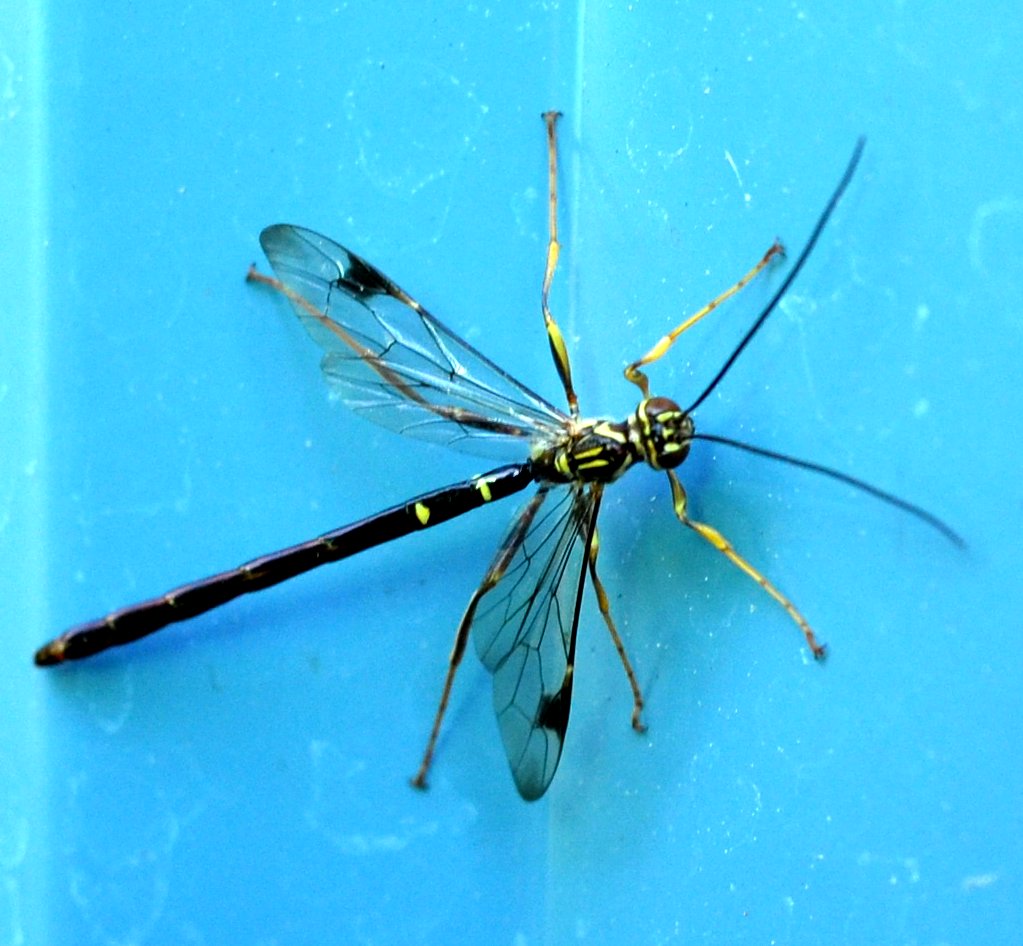
What a romp! I'd like now to show you some of my tiny spider pictures. I particularly love the crab spiders, running crab spiders and ground crab spiders. This one is a ground crab spider on the workshop siding, and seems still to be in the throes of catching an ant. Next is a crab spider on a dame's rocket petal - you can see how it is waiting quietly for some insect to turn walk past - you can also see how it is quivering with anticipation! The pink and white running crab spider is focusing its attention on me so it will probably miss what it was focusing on before.
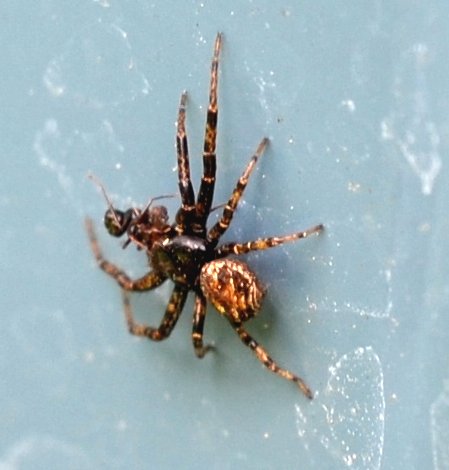
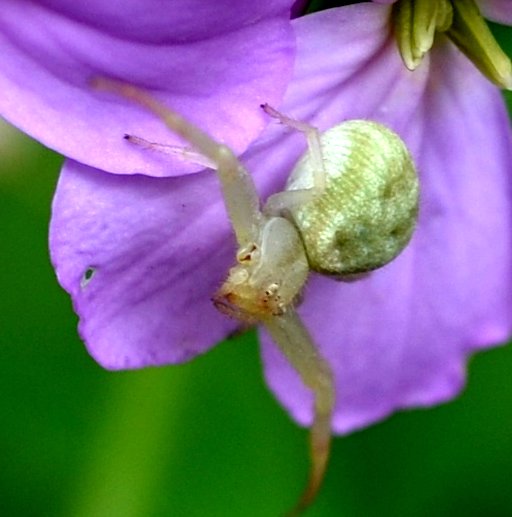
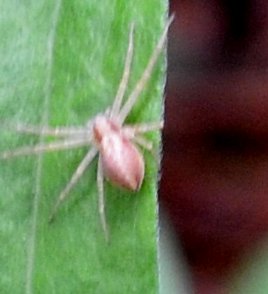
These are good days to sidle along a lightly stepped path, and suddenly see something very tiny that seems to be on a strand of silk. I like to pull a folding chair along till I'm sitting on it and focused on the tiny something. Finally the "auto"-focus pulls it into view and I see one of the very tiny species of spider that was visible on the siding a month or more earlier. In this way, I can sometimes get an image of something that was labeled "to zoom in on" a bit earlier. For example, this Mangora placida (two images) is seen to be a greater grander copy of the tiny spider we earmarked in February. And here is the Orchard Orbweaver (two images).
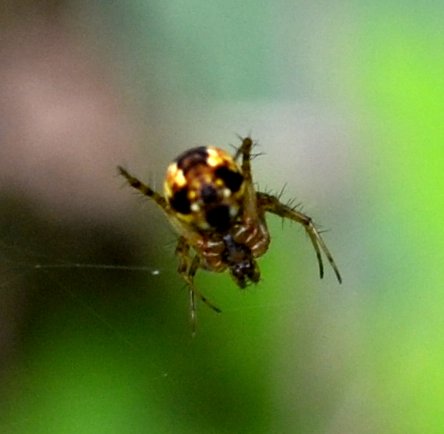
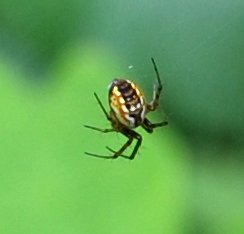
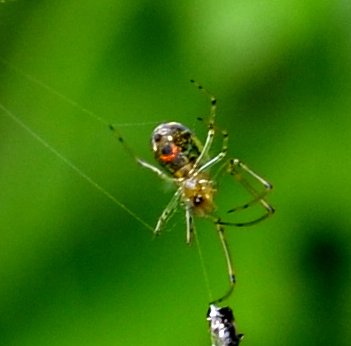
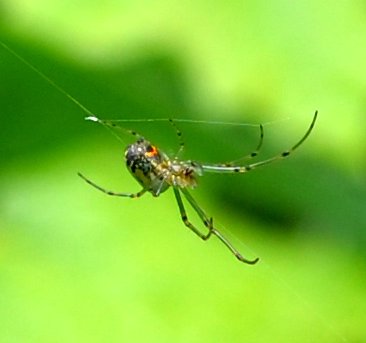
The tadpoles are growing and growing. It's now been almost a month of their lives as tiny aquatic animals. And the good news is that we aren't the only toad fanciers around here. Here is a picture taken by Kathleen Seidl on her land. Looks like an American toad to me! Finally, a burst of orange as the poppies seem to be returning to the yard!
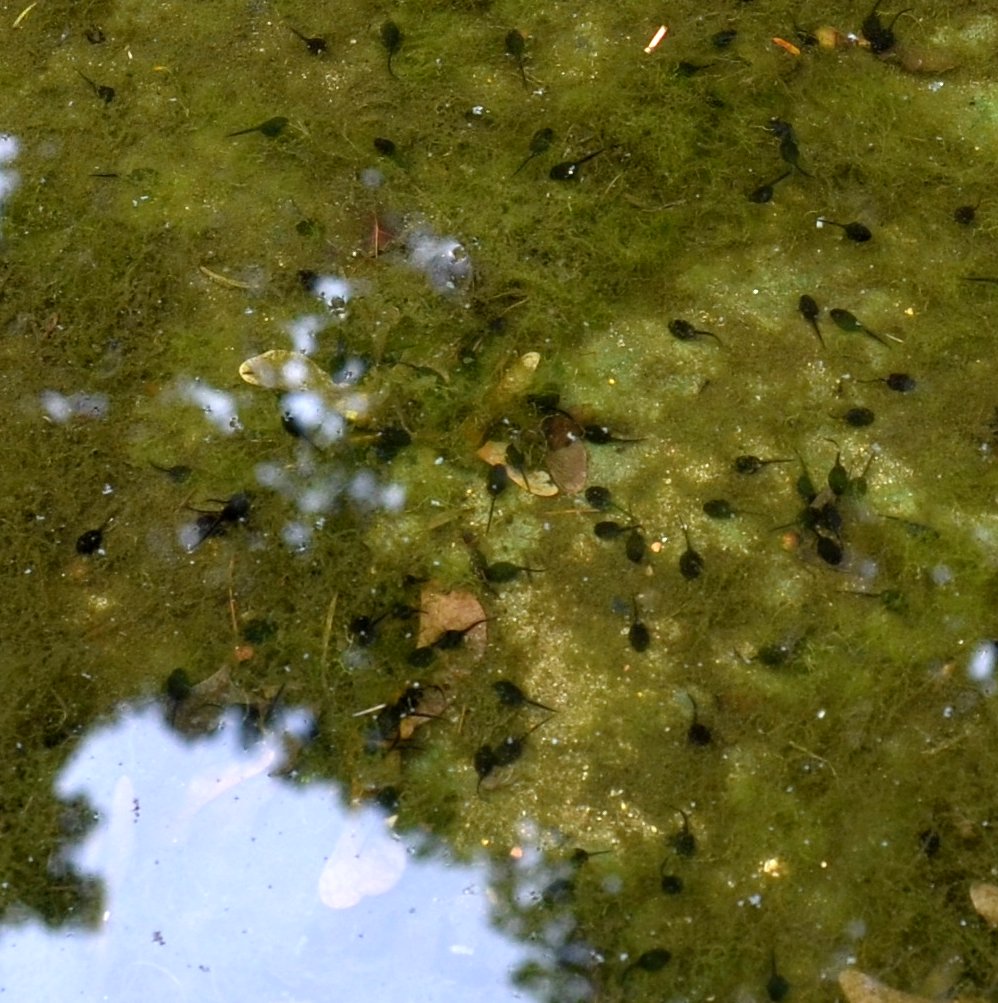
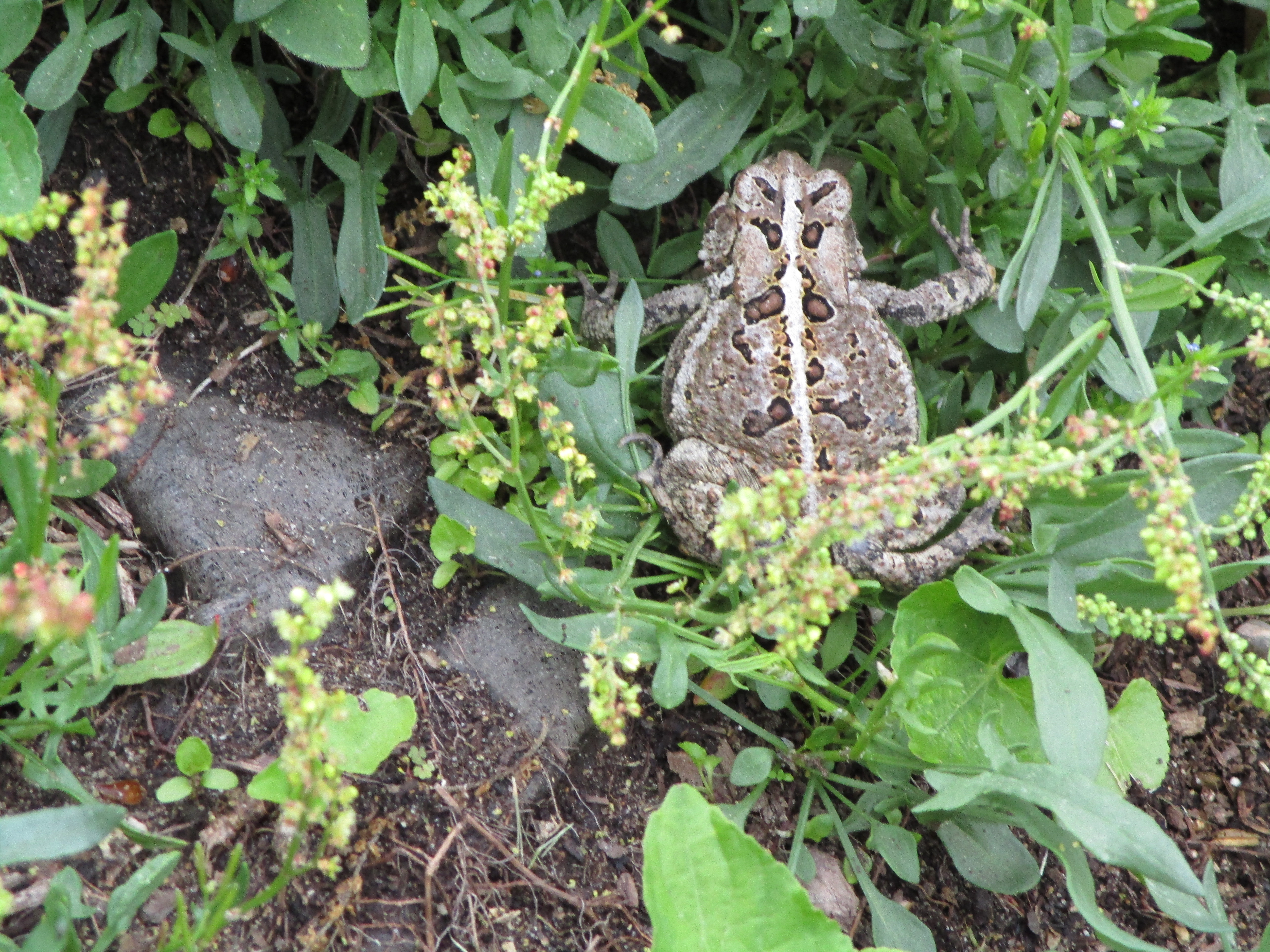
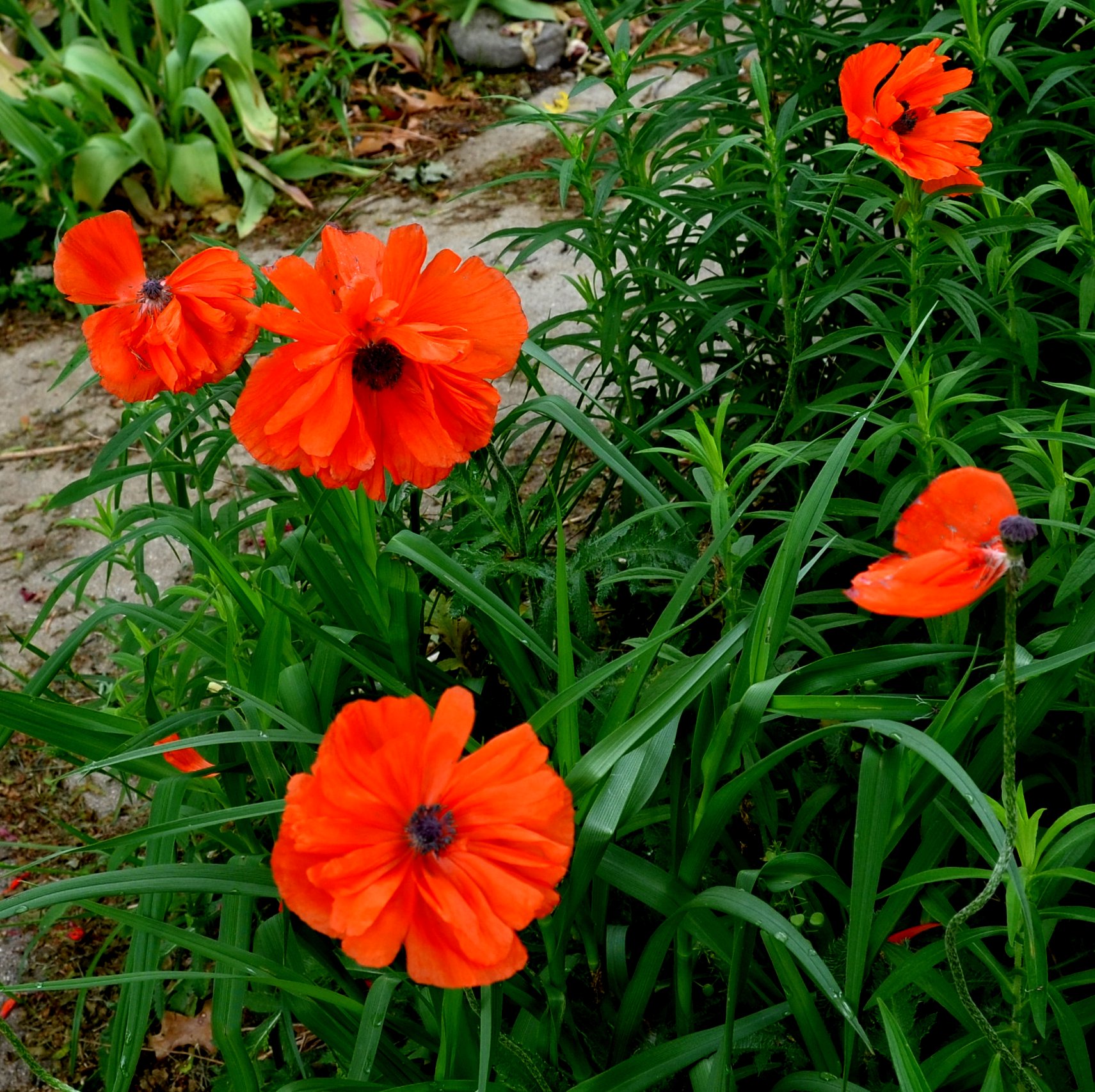
So that is it. I've been recovering from my respiratory problems and hope this one is about over! For all of YOU, I wish a continued opening out of the new season!
Love, Martha
Back to May 21, 2017
Forward to June 4, 2017
Back to 2017 menu














































 5 20 17 2.jpg)
 5 21 17 1.jpg)






























